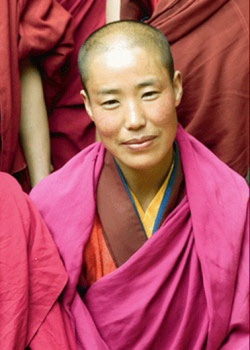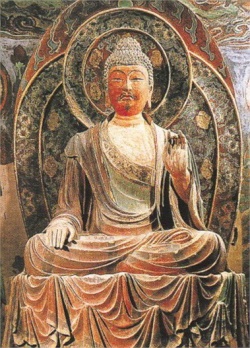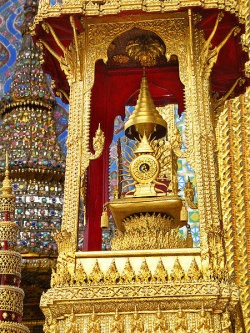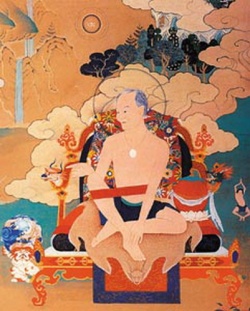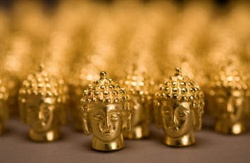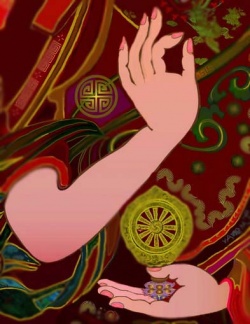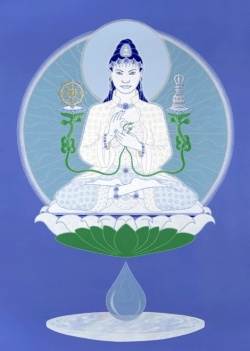Maha Pajapati Gotami
Mahāpajāpatī Gotamī (in Pali; Mahāprajāpatī Gautamī in Sanskrit) was the first woman to request ordination from the Buddha and to join the Saṅgha. Mayadevi and Mahāpajāpatī Gotamī were the Koliyan Princess and was sisters of Suprabuddha . She was both the Buddha's maternal aunt and adoptive mother, raising him after her sister, Queen Maya (Mahāmāyā), the Buddha's birth mother, died. Mahapajapati Gotami died at the age of 120.
Early life
An eminent Therī, Mahāpajāpatī was born at Devadaha, in the family of Suppabuddha, as the younger sister of Mahāmāyā. Mahāpajāpatī was so called because, at her birth, augurs prophesied that she would have a large following. Both sisters married King Śuddhodana, leader of the Śākya. When Mahāmāyā died, seven days after the birth of the Buddha, Pajāpati looked after the Buddha and nursed him. She raised the Buddha and had her own children, Siddhartha's half-brother Nanda and half-sister Sundari Nanda, but it is said that she gave her own children to nurses and herself nursed the Buddha.
Ordination of the first woman
When her sister, Queen Maya, died, Mahapajapati Gotami decided to attain Ordination. Mahapajapati Gotami went to the Buddha and asked to be ordained into the Sangha. The Buddha refused and went on to Vesāli. Undaunted, Gotami cut off her hair and donned yellow robes and with a large number of Sakyan ladies followed the Buddha to Vesāli on foot. Upon arrival, she repeated her request to be ordained. Ananda, one of the principal disciples and an attendant of the Buddha, met her and offered to intercede with the Buddha on her behalf.
Respectfully he questioned the Buddha, "Lord, are women capable of realising the various stages of sainthood as nuns?"
"They are, Ananda," said the Buddha.
"If that is so, Lord, then it would be good if women could be ordained as nuns," said Ananda, encouraged by the Buddha's reply.
"If, Ananda, Maha Pajapati Gotami would accept the Eight Conditions it would be regarded that she has been ordained already as a nun."
Gotami agreed to accept the Eight Conditions and was deemed a Bhikkhuni.
In the thirteenth chapter of the Mahayana Lotus Sutra, Mahaprajapati receives a prediction from Sakyamuni Buddha that she will attain Buddhahood in a future lifetime.
Pajapati Gotami was the younger sister of Queen Maha Maya and the second consort of King Suddhodana. She was called Maha (great) Pajapati as sages had predicted that she would be the leader of a large following. When her beloved sister passed away seven days after giving birth to Prince Siddhattha, she was desolated. They had been very close as sisters. She decided that she would bring up her sister's baby as her own.
Delegating the care of her own son, Nanda, to nurses, Maha Pajapati nursed the new-born babe. Both King Suddhodana and Maha Pajapati adored the gentle Prince. Prince Siddhattha grew up in luxury with His stepbrother and stepsister, Nanda and Nanda, Maha Pajapati's two children.
When the Buddha visited Kapilavatthu and dispensed the Dhammapala Jataka to King Suddhodana, Maha Pajapati attained the first stage of sainthood, Sotapanna. After King Suddhodana passed away, Maha Pajapati decided that she too would enter the Noble Order and lead the holy life under the Buddha. Her son, Nanda, and grandson, little Rahula, had entered the Order under the great sage. Pajapati no longer had any desire for worldly pleasures.
The Buddha was visiting Kapilavatthu to settle a dispute that had arisen between the Sakyans and the Koliyas regarding the waters of the Rohini River when Maha Pajapati first approached Him with the request to permit women to enter the Noble Order. Without stating the reason the Buddha refused, saying, "O Gotami, let it not please you that women should be allowed to do so". Maha Pajapati, however, did not give up. A second and a third time she requested ordination for women. In each instance the Buddha gave the same reply.
The Buddha then proceeded to Vesali to reside at the Mahavana in the Kutagara Hall. The determined Maha Pajapati was not discouraged. Cutting off her hair, she donned the yellow robes of a monk, and with a large retinue of Sakyan ladies, walked the 150 miles to Vesali. Covered in dust, her feet swollen and bleeding, she stood outside the hall, weeping. When ananda, the Buddha’s personal attendant, saw her and heard the cause of her grief, he decided to approach the Buddha on her behalf.
The compassionate ananda pleaded on behalf of the ladies. When the Buddha refused, ananda asked Him if He felt that women were incapable of reaching spiritual heights and Arahanthship. The Buddha replied that women were as capable as men of attaining spiritual development. He then looked back into Maha Pajapati’s past lives. Seeing that Maha Pajapati had made an aspiration many aeons ago to initiate the order of the nuns, the fulfilment of which was to occur during His dispensation, the Buddha relented, granted ananda’s request, and formed the order of the nuns.
The Buddha did not give the reason for His initial refusal to Maha Pajapati. All the Buddhas of the past had had the order of the nuns. The Gotama Buddha would have seen this and realized that the female order was a part of every Buddha’s retinue. As such, some speculate that He was testing Pajapati's determination and resolution, as the holy life for women, especially women of royal birth, would be difficult and entail many hardships. Some speculate that the initial refusal was also because of the society and its treatment of women at that time, and the Buddha's fear for the safety of the female order. In general, it is felt that the initial refusal was to strengthen the determination and resolve of the noble ladies and to prepare them better for the hardships they would have to face.
In India at the time of the Buddha, women were thought to be inferior to men. They did not have much freedom and were often not treated with respect. Women from noble families were carefully secluded and shielded from abuse. The men ensured the safety of the women. The Buddha's disciples often meditated in forests and walked alone from city to city on lonely roads, preaching the Dhamma. How was He to ensure the safety and protection of the nuns? How was He to ensure they would be treated with respect and fairness? How was He to entrust the safety of the nuns to monks who had taken the vows of celibacy? Would it not then be harder for the monks to be disciplined?
The Buddha dispensed eight extra disciplinary (Vinaya) rules for the nuns, mostly regarding the manner in which they would have to respect and honour the monks who through necessity, would have to protect them. He also prophesied that ordination of nuns would result in the shortening of the time span in which His teachings would remain on Earth.
While some women in the modern world may find it difficult to accept some of these rules, we should place them in the context of the role and position of women at the time of the Buddha, to fully appreciate the bold radical change that the Buddha instigated.
The Eight Monastic Regulations applicable to women were:
1. A Bhikkhuni (nun) should always respect a Bhikkhu (monk) even if the monk were junior to her in the order. Among the Bhikkhus the junior monks in the order respected the senior monks just as the junior nuns respected the senior nuns.
2. A Bhikkhuni shall not spend the rainy season in a place where there are no monks. (The attitude prevalent in India towards women at the time of the Buddha necessitated this precaution for the safety of the nuns).
3. Twice a month the Bhikkhuni shall ask the Bhikkhus the time when the monastic discipline (Uposatha) is recited and request for a monk to come to advise and admonish the Bhikkhunis (who have deviated from monastic rules).
4. At the termination of the rainy season retreat, the final ceremony shall be held in an assembly of both monks and nuns.
5. Certain offences committed by Bhikkhunis should be dealt with by assemblies of both Bhikkhus and Bhikkhunis. The assembly of Bhikkhunis deals with only minor transgressions and some of a personal nature to women.
6. A novice Bhikkhuni shall receive higher ordination after a training period of two years. There are instances when monks were given higher ordination immediately after ordination.
7. A Bhikkhuni should not rebuke a Bhikkhu under any circumstances.
8. Even though Bhikkhunis cannot admonish Bhikkhus, a Bhikkhu can admonish a Bhikkhuni who has transgressed the monastic discipline.
Maha Pajapati and her retinue of Sakyan ladies accepted the eight extra discipline rules and received ordination from the Buddha. The Buddha was the first religious teacher to form the order of the Bhikkhunis (nuns). The nuns were then guided under similar monastic rules as the monks. The Buddha appointed two chief female disciples (as he had appointed two chief male disciples) to help with His growing congregation of nuns. Subsequent to this, new rules were added to the discipline as and when required by circumstance. For example, Bhikkhunis were not allowed to meditate and reside on their own in forests after an incident that occurred regarding the Bhikkhuni Uppalavanna.
The Buddha’s monastic discipline (five books) for Bhikkhus and Bhikkhunis is an exemplary democratic system from which we can still learn. The exceptionally high moral standards of the Sangha and the unsurpassed administrative system the Buddha instituted were well thought out and futuristic. Lord Zetland, a former viceroy of India, writes, "And it may come as a surprise to many to learn that in the assemblies of the Buddhists in India, two thousand years and more ago, are to be found the rudiments of our own parliamentary practice of the present day."
Before long, Maha Pajapati attained Arahanthship, as well as intuitive and analytical knowledge. Her retinue of Sakyan ladies too attained Arahanthship. Maha Pajapati was assigned the foremost place in seniority and experience.
In gratitude, Pajapati paid reverence to the Buddha and to her beloved sister, Maya, who had brought the Noble Baby into the world, as follows:
"Buddha, Hero, homage to you,
O best of all beings
Who released me and many other beings from pain.
All pain is known: craving as the cause is dried up;
The Noble Eightfold way has been developed,
Cessation has been attained by me.
Formerly I was mother, son, father, brother and grandmother;
Not having proper knowledge
I journeyed on (in samsara) without expiation.
I have indeed seen the Blessed One;
This is the last body.
Journeying on from rebirth to rebirth has been eliminated;
There is now no renewed existence (for me).
I see the disciples all together,
Putting forth energy, resolute, always with strong effort.
This is homage to the Buddhas.
Truly for the sake of many,
Maya bore Gotama.
She thrust away the mass of pain
Of those struck by sickness and death."
-- (Therigatha 157-162)
Maha Pajapati aspired to institute the Order of the Nuns at the time of the Padumuttara Buddha. She had observed the Buddha Padumuttara confer a similar title on another nun. Inspired by that nun, she had wanted to hold a similar position at the time of a future Buddha. With this in mind she had given alms to the Padumuttara Buddha and His retinue and made an aspiration. The Buddha, foreseeing that her aspiration would be fulfilled, had prophesied that she would, at the time of the Gotama Buddha, be foremost among the nuns in seniority and experience and would start the Order of the Nuns. From this point onwards, Maha Pajapati had performed meritorious deeds and strived with effort to practise the Dhamma.
The next documented birth story takes place at a time when there was no Supreme Buddha. Pajapati was born to a wealthy family and was attended on by 500 maidservants. She had observed five Pacceka Buddhas come to the city in search of shelter for the rainy season. Together with her maidservants, she had built five shelters for the Buddhas and furnished them. She had then invited the five Pacceka Buddhas, and together with her servants, had provided them with meals for the entire three months of the rainy season. At the end of the season, together with her maids, she had sewn the Kathina robes to be gifted to the Buddhas. At death Pajapati and her five hundred maids were reborn in a heavenly realm and enjoyed the pleasures of heavenly bliss for a long time.
Her next documented birth is as Maha Pajapati, foster mother and aunt to Prince Siddhattha. With determination and tireless effort she had practised the Dhamma over countless aeons to fulfil the aspiration made one hundred thousand world cycles ago.
The Licchavi Kings of Vesali built a large nunnery for Maha Pajapati and her retinue of five hundred Sakyan princesses. Pajapati was a role model for all the nuns but specifically so to other ladies of noble birth. She encouraged and helped them to adjust to the solitary austere life of a nun. She also assisted in the teaching and administration of novice nuns. As she approached her 120th year, Maha Pajapati realized that she had not long to live. It was time for her to pay homage for the last time to the Buddha, who had taught her the nectar of the Dhamma and helped her attain Nibbana. Approaching the Buddha she said:
"O Lord! I brought up your physical body but
You brought up my spiritual body.
I fed you with breast-milk but
You fed me with the milk of the Dhamma,
To destroy suffering and Samsara.
It is a rare opportunity to see a Buddha.
I would like to view and pay homage
to your lotus-like feet.
Please stretch forward your feet."
The Buddha with compassion stretched out His feet, which resembled the pink lotus flower. Falling at His feet and revering the Great Markings that signified an Enlightened Being, Pajapati worshipped Him and begged forgiveness for any shortcomings she may have had. Then she requested permission to pass away.
The news of the imminent passing away of Pajapati spread far and wide. Monks and nuns gathered to pay respect and homage to her. Sariputta, Moggallana, Nanda, Rahula, ananda, Khema, Uppalavanna, and many others gathered at Vesali. ananda, who was as yet only Sotapanna, started to weep. Pajapati then consoled him by reminding him of the great service he had performed to her by speaking on her behalf to the Buddha to form the Order of Nuns. She then gently advised ananda not to weep, as it was not appropriate that the monk foremost in retentive memory should weep.
Despite the Buddha’s acknowledgement of the intellectual capabilities of women, there were many men who were not willing to change the views that had been ingrained in them for years. The Buddha called Pajapati and said, "O Gotami, it is very rare to see a lady like you (a former queen) attain enlightenment. Perform a miracle to dispel the wrong views of those foolish men who are in doubt with regard to the spiritual potentialities of women."
Pajapati then rose in the air and came down and worshipped the Buddha. Three times she paid homage to Him thus, then she disappeared and reappeared before the crowd. Finally accepting permission from the Buddha to attain Parinibbana, she walked backwards with her eyes on the Buddha towards the nunnery. The Buddha then instructed all to join Him to follow her for her last send-off. Pajapati entered the nunnery and, seated in the lotus position, entered into deep meditation, attained the Jhanas, and passed away to the Bliss of Parinibbana.
The Licchavi kings placed the remains of Pajapati in a golden casket and carried it through the city in a grand procession. The respect that the Buddha had for His foster mother and mothers in general was seen at Maha Pajapati’s funeral. The Buddha, who never walked behind anyone, walked behind the carriage that carried her body. In this way, by example, the Buddha showed us that we should respect and honour our mothers for the care and love that they have given us when we were too young to take care of ourselves. Hundreds of monks and nuns followed the carriage to the cremation ground. The casket was then placed on a sandalwood pyre and sprinkled with jasmine and other fragrant oils. The Licchavi kings then lighted the pyre.
The relics of Maha Pajapati are said to have turned white like glowing pearls. ananda collected the relics and handed them over to the Buddha and later to the Licchavi kings. A Stupa was built by the kings to enshrine Maha Pajapati’s relics. Women from all over the world pay respect and homage to Maha Pajapati in gratitude for initiating the Order of Nuns.
